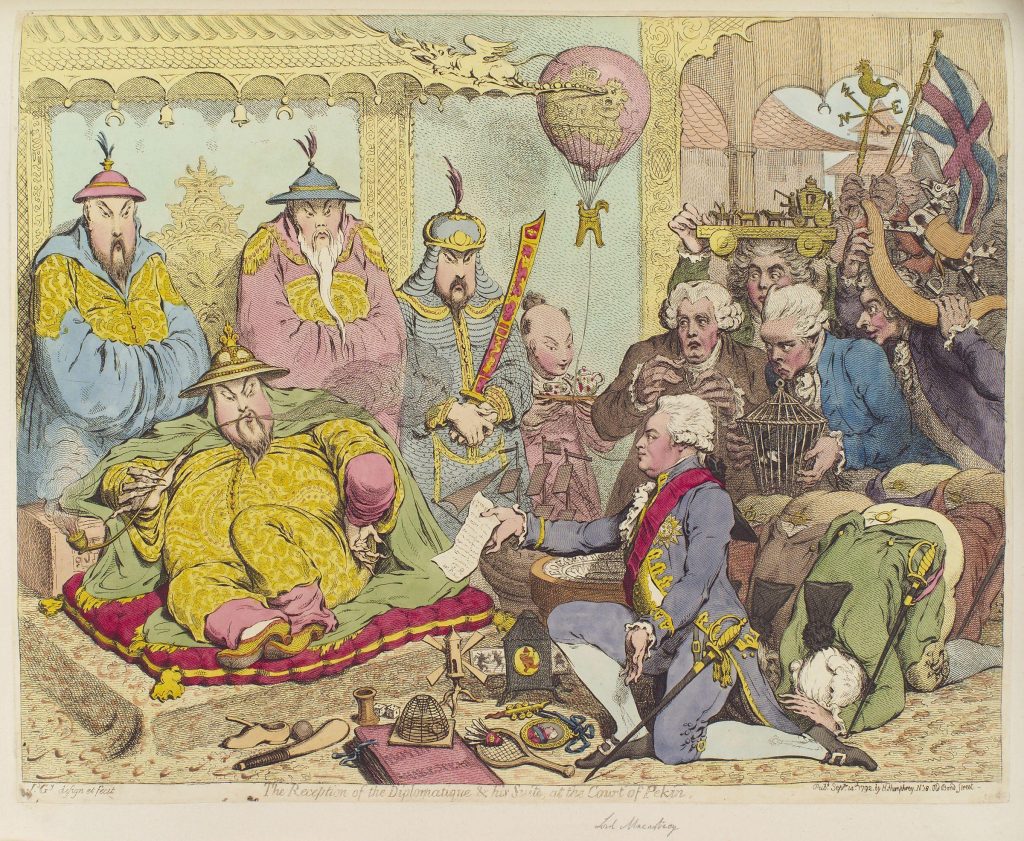The Water-Cooler Problem

George Macartney had a bad day at work. The deal he was sent to close was rejected, despite months of advance negotiation. He followed the agreed-upon protocols, though they made both parties uncomfortable. He returned home feeling misunderstood and empty-handed.
Macartney did not fly home on a jet, scouring business magazines for a refresher on international business etiquette. It was 1793. He had a long journey home by ship, and months to muse on the failure of the first British diplomatic mission to China.
The challenges Macartney faced went beyond not showing appropriate deference to his hosts (though arguably he didn’t—instead of the subservient act of kneeling, hand-kissing, and touching the ground with his forehead as was Chinese custom, he genuflected on one knee). Ultimately, the Chinese emperor Qianlong refused the British request for more open trade because of fundamentally differing views of the world. The British believed they had goods of value to offer a partner; the Chinese saw goods with little value from subjects under the emperor’s divine rule. Even the hundreds of gifts that Macartney brought as a show of good faith, and as a taste of what trade could bring, were seen by the Chinese as no more than tribute from a submissive regime. These people from very different cultures started from different vantage points and had different objectives and different methods for trying to achieve them.
Today a multitude of technologies—email, instant messaging, videoconferencing—have shrunk the distances between people and cultures. The barriers of the kind Macartney experienced should have fallen by now. Instead, differences in vantage point, objective, and method still lead to misunderstandings, missed deadlines, failed deals, and, often, general unhappiness in companies around the world.
Why do these problems persist between countries and companies, and even among people working for the same company toward the same goal?
The business world is increasingly seeking answers to such questions from anthropologists like myself. In the late 1970s, the California-based R&D company Xerox PARC hired social scientists to help them develop artificial intelligence; they ended up looking at human work practices and how to improve them. Today, ethnographic views can really change the mindset of a business regarding everything from market research to product design to internal company structure, and more. Companies like Intel, Google, and IBM rely on social scientists to predict consumers’ desires and technology needs years into the future.
A few years ago, I ran a project to understand the work practices of a global group of hardware and software designers—comprised of technical personnel spread across five countries and six time zones—within a Fortune 500 company.
A relatively new division of the group had been set up in a country with a cheaper workforce, and there was a mandate to send work there. For the North Americans in the group, this was irritating. They resented the time it took to train the new employees, who didn’t have the same culture of showing initiative and doing things on their own (one engineer described his own group as “cowboys” who just went ahead and did whatever was needed). The behaviors, values, and objectives of the employees in the new country seemed foreign and strange. Misunderstandings were rife, so a policy was implemented to back up phone conversations in writing by email, which took even more time and sparked more irritation.
The vice president of the group wanted more collaboration among all the employees. But not everyone thought lack of collaboration was a problem. Engineers and others felt their work was different and independent. They felt they were, and should be, isolated from far-flung colleagues. They might have been right. Perhaps their work was different. But at least part of the problem was the social chasm created by physical distance, even with the use of digital technologies that are supposed to close that gap.
More than 220 years after Macartney’s trip, China and the Western world are still struggling to understand each other.
People always have a view of “us” and “them.” Distance enhances the sense of otherness, while proximity enhances the sense of closeness and understanding. When people work in the same location, informal interactions happen naturally, and the unknown becomes known amidst conversations about the weather, the commute, or families. Such chats can suddenly make the unfamiliar seem more familiar. In my research, I discovered that the company had some workers who were able to more effectively close these interpersonal gulfs. Employees based in Australia felt relieved to delegate some of their workload to the new staff. Part of the difference in attitude probably came down to time: The Australians were closer in time zone and had more overlap in their day to speak with, and get to know, the new hires.
The problem faced by this company, like many companies today, is a water-cooler problem for the 21st century: In the digital age, how can people who remotely work together come to casually know each other when they live so far apart?
Long-distance work relationships, like long-distance romances, can take a lot more effort than anyone might plan for. Extra time needs to be carved out to make things run smoothly. At least in romance, both parties have a strong incentive to keep in touch; in the workplace, it may only be a third party who wants to make things work.
My research shows that businesses need to both give their employees time to get to know one another, and reward efforts to do so. The key is to make collaboration part of the goal and provide awards for teams who work well together.
New technologies can help. IBM created its own internal social network, Beehive, to enable employees to connect with colleagues who share similar interests. Likewise, commercial tools such as Yammer and Salesforce Chatter provide corporations with activity feeds.
But these tools only work if they are customized to meet a real need of the workers, rather than being an edict forced on lower-level staff by senior management. Forcing people to have virtual water-cooler chats using a new tool makes it just another chore. It can create more conflicts, rather than easing them.
For now, it seems these tools can’t entirely replace the value of face-to-face meetings. In the company I surveyed, the older staff deeply missed the corporate technical conferences the company used to host but had cut in the interest of saving money. As one employee noted, the conferences “went a long way to meeting people [and forming a] personal bond in a project.” Corporations may think they’re saving money on travel budgets, but springing for an annual get-together may, in the end, save them more by preventing culture clashes.
These getting-to-know-each-other sessions can take a long time. More than 220 years after Macartney’s trip, China and the Western world are still struggling to understand each other. The Asian cultural tendency to put the collective ahead of individuals, for example, has led to the quick introduction of Chinese products to market, while Western inventors worry about losing control of their intellectual property. But in today’s world, as much as in the world of Macartney and Emperor Qianlong, international trade and partnership requires intercultural and interpersonal understanding. We must learn to work together, even from a distance.
































